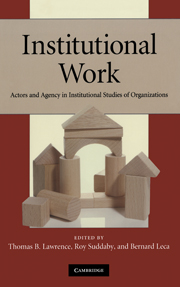Book contents
- Frontmatter
- Contents
- List of figures
- List of tables
- List of contributors
- 1 Introduction: theorizing and studying institutional work
- Part I Essays on institutional work
- 2 Institutional work and the paradox of embedded agency
- 3 Leadership as institutional work: a bridge to the other side
- 4 Bringing change into the lives of the poor: entrepreneurship outside traditional boundaries
- 5 Institutional work as the creative embrace of contradiction
- Part II Studies of institutional work
- Index
- References
3 - Leadership as institutional work: a bridge to the other side
Published online by Cambridge University Press: 15 September 2009
- Frontmatter
- Contents
- List of figures
- List of tables
- List of contributors
- 1 Introduction: theorizing and studying institutional work
- Part I Essays on institutional work
- 2 Institutional work and the paradox of embedded agency
- 3 Leadership as institutional work: a bridge to the other side
- 4 Bringing change into the lives of the poor: entrepreneurship outside traditional boundaries
- 5 Institutional work as the creative embrace of contradiction
- Part II Studies of institutional work
- Index
- References
Summary
The great deed of the supreme hero is to come to the knowledge of this unity in multiplicity and then to make it known.
– Joseph Campbell, The Hero with a Thousand FacesThe most important thing is integrity. Once you figure out how to fake that you've got it made.
– Variously attributedCurrent interest in the phenomenon of institutional work was seemingly foreshadowed by Selznick (1957) in his Leadership in Administration. Therein, he developed a powerful theory of the institution which granted a central role to a particular type of institutional worker: the leader or “statesman.” He saw leaders as playing an essential part in institutionalization processes, and focused in particular on the ways in which they help institutions develop, adapt, and endure. Selznick's concept of institutional leadership would thus appear to link quite well with the more contemporary concept of institutional work, which Lawrence and Suddaby (2006: 215) have defined as “purposive action of individuals and organizations aimed at creating, maintaining and disrupting institutions.” However, this linkage remains a latent and largely undeveloped one. Lawrence and Suddaby's (2006) exhaustive review of the burgeoning literature on institutional work cited no studies of institutional leadership and made no explicit reference to Selznick's concept or his 1957 book. While this omission may reflect an oversight on those authors' part, it also says something about the current state of the field. Contemporary institutionalists have become increasingly interested in agency, practice, power, entrepreneurship, and like issues.
- Type
- Chapter
- Information
- Institutional WorkActors and Agency in Institutional Studies of Organizations, pp. 59 - 91Publisher: Cambridge University PressPrint publication year: 2009
References
- 103
- Cited by

